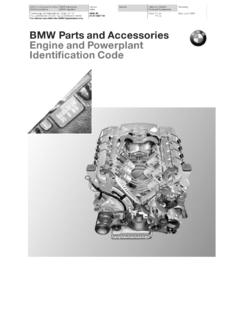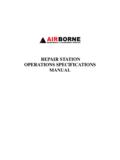Transcription of TITLE 14—CIVIL AVIATION - The IPL Group LLC
1 civil AIR REGULATIONS PART 4b-AIRPLANEAIRWORTHINESS TRANSPORTCATEGORIESAs amended to December 31, 1953 civil AERONAUTICS BOARDWASHINGTON, 14 civil AVIATIONC hapter 1 civil Aeronautics BoardSubpart A civil Air RegulationsPart 4b AIRPLANE AIRWORTHINESS;TRANSPORT CATEGORIESRECAPITULATION OF PARTB ecause of the number of outstandingamendments to Part 4b there follows a recapitulationof Part 4b incorporating all amendments up toDecember 31, A GeneralAPPLICABILITY AND of this for type of applicable of and , experimental, andproduction of materials, parts, processes,and in type B of of gravity limitations on of flap ; ; ; all engines of the landing distance; or float ; and lateral control speed, and directional , directional, and lateral for airplanes with four or longitudinal during during during during longitudinal directional and lateral directional and lateral ; symmetrical ; asymmetrical HANDLING stability and stability and cross HANDLING and stability on the FLIGHT and C and of of high lift flight flight SURFACE AND SYSTEM surface loads; flight control primary flight control gust control landing landing landing drift landing handling loads on dual-wheel weights and center of of and main float load and main float landing and main float take-off and main float bottom float LANDING ditching D Design and strength properties and , deformation, and of controls and flap flat system system system details.
2 Gear load factor AND main AND CARGO compartment; compartment; and , berths, and safety and baggage , HEATING, AND cabins; and baggage compartment of fluid fire heater fire near E powerplant pitch and speed de-icing SYSTEM OPERATION AND system cross-feed flow of unusable fuel supplyand fuel system operation on low system hot weather between interconnected SYSTEM CONSTRUCTION AND tank tank tank expansion tank tank filler tank vents and carburetor tank fueling SYSTEM pump system lines and lines and fittings in designated system jettisoning tank tank tank lines and system feathering cooling test cooling test test procedure for flying cooling system AND EXHAUST system de-icing and air preheater system system air and system and CONTROLS AND controls.
3 And system system air preheat Ignition FIRE fire and extinguisher detector and nacelle accessory section and ventilation of fire of other airplane componentsagainst F and installational basic and navigational , systems, and ; and visibility of and navigational SYSTEMS AND system equipment and system fire and system tests and light system light system dihedral light distribution and light color fire belt of safety and electronic equipment and systems; systems system fire G Operating Limitations and limitations; speed operating limit speed extended speed gear operating speed gear extended speed control speed weight, center of gravity andweight distribution flight of operating flight load factorsMARKINGS AND markings; direction instruments; quantity quantity markings; markings and FLIGHT IDENTIFICATION : to issued undersec.
4 205, 52 Stat. 984, as amended: 49 or apply secs. 601, 603, 52 Stat. 1007, asamended, 1009, as amended; 49 551, A GENERALAPPLICABILITY AND DEFINITIONS of this part. This partestablishes standards with which compliance shall bedemonstrated for the issuance of a type certificate fortransport category airplanes. This part, untilsuperseded or rescinded, shall apply to all transportcategory airplanes for which applications for typecertification in the transport category are made afterthe effective date of this part (November 9, 1945). As used in this part termsare defined as follows:(a)Administration (1) Administrator. TheAdministrator is the Administrator of CivilAeronautics.(2)Applicant. An applicant is a person orpersons applying for approval of an airplane or anypart thereof(3)Approved. Approved, when used alone oras modifying terms such as means, devices,specifications, etc., shall mean approved by theAdministrator.
5 (See )(b)General design (1) Standard standard atmosphere is an atmosphere defined asfollows:(i)The air is a dry, perfect gas,(ii)The temperature at sea level is 59 F.,(iii)The pressure at sea level is inches Hg,(iv)The temperature gradient from sea level tothe altitude at which the temperature equals -67 F. is and zero there above(v)The density 0 at sea level under the aboveconditions is pounds sec. (2)Maximum anticipated air temperature. Themaximum anticipated air temperature is a temperaturespecified for the purpose of compliance with thepowerplant cooling standard. (See (b).)(3)Airplane configuration. Airplaneconfiguration is a term referring to the position of thevarious elements affecting the aerodynamicscharacteristics of the airplane ( , wing flaps,landing gear).(4)Aerodynamic coefficients. Aerodynamiccoefficients are nondimensional coefficients for forcesand moments. They correspond with those adoptedby the National Advisory Committee forAeronautics.
6 (5)Critical engine(s). The critical engine isthat engine(s) the failure of which gives the mostadverse effect on the airplane flight characteristicsrelative to the case under consideration.(6)Critical-engine-failure speed. The critical-engine-failure speed is the airplane speed used in thedetermination of the take-off at which the criticalengine is assumed to fail. (See ).(c)Weights (1) Maximum weight. Themaximum weight of the airplane is that maximum atwhich compliance with the requirements of this part isdemonstrated. (See (a).)(2)Minimum weight. The minimum weight ofthe airplane is that minimum at which compliance withthe requirements of this part is demonstrated. ( (c).)(3)Empty weight. The empty weight of theairplane is a readily reproducible weight which is usedin the determination of the operating weights. (See )(4)Design maximum weight. The designmaximum weight is the maximum weight of the airplaneused in structural design for flight load conditions.
7 (See )(5)Design minimum weight. The designminimum weight is the minimum weight of the airplaneat which compliance is shown with the structuralloading conditions. (See )(6)Design take-off weight. The design take-offweight is the maximum airplane weight used instructural design for taxying conditions, and forlanding conditions at a reduced velocity of descent.(See )(7)Design landing weight. The design landingweight is the maximum airplane weight used instructural design for landing conditions at themaximum velocity of descent. (See (b).)(8)Design unit weight. The design unit weightis a representative weight used to show compliancewith the structural design requirements.(i)Gasoline 6 pounds per gallon.(ii)Lubricating oil pounds per gallon.(iii)Crew and passengers 170 pounds perperson.(d)Speeds (l) IAS: Indicated air speed is equalto the pitot static airspeed indicator reading asinstalled in the airplane without correction forairspeed indicator system errors but including the sealevel standard adiabatic compressible flow correction.
8 (This latter correction is included in the calibration ofthe air-speed instrument dials.) (See (a) )(2)CAS: Calibrated air speed is equal to theair-speed indicator reading corrected for position andinstrument error. (As a result of the sea leveladiabatic compressible flow correction to theair-speed instrument dial, CAS is equal to the true airspeed TAS in standard atmosphere at sea level.)(3)EAS: Equivalent air speed is equal to theair-speed indicator reading corrected for positionerror, instrument error, and for adiabatic compressibleflow for the particular altitude. (EAS is equal to CASat sea level in standard atmosphere.)(4)TAS: True air speed of the airplane relativeto undisturbed air. (TAS=EAS ( 0/ )1/2.)(5VA: The design maneuvering speed. (See (b) (2).)(6)VB: The design speed for maximum gustintensity. (See (b)(3).)(7)VC: The design cruising speed. (See (b)(4).)(8)VD: The design diving speed.)
9 (See (b)(5).)(9) VDF: The demonstrated flight diving speed.(See )(10)VF: The design flap speed for flight loadingconditions with wing flaps in the landing position.(See (b) (1).)(11)VFE: The flap extended speed is a maximumspeed with wing flaps in a prescribed extendedposition. (See )(12)VLE: The landing gear extended speed is themaximum speed at which the airplane can be flownsafely with the landing gear extended. (See )(13)VLO: The landing gear operating speed is amaximum speed at which the landing gear can beraised or lowered safely. (See )(14)VMC: The minimum control speed with thecritical engine inoperative. (See )(15)VNE: The never-exceed speed. (See )(16)VNO: The normal operating limit speed. (See )(17)VSO: The stalling speed or the minimumsteady flight speed with wing flaps in the landingposition. (See (a) and )(18)Vs1: The stalling speed or the minimumsteady flight speed obtained in a specifiedconfiguration.
10 (See (b).)(19)V1: The critical-engine-failure speed. (See )(20)V2: The take-off safety speed. (See (b).)(e)Structural (1) Limit load. A limit load isthe maximum load anticipated in normal conditions ofoperation. (See )(2)Ultimate load. An ultimate load is a limitload multiplied by the appropriate factor of safety.(See )(3)Factor of safety. The factor of safety is adesign factor used to provide for the possibility ofloads greater than those anticipated in normalconditions of operation and for uncertainties indesign. (See (a).)(4)Load factor. The load factor is the ratio of aspecified load to the total weight of the airplane; thespecified load may be expressed in terms of any of thefollowing: aerodynamic forces, inertia forces, orground or water reactions.(5)Limit load factor. The limit load factor is theload factor corresponding with limit loads.(6)Ultimate load factor. The ultimate loadfactor is the load factor corresponding with ultimateloads.




